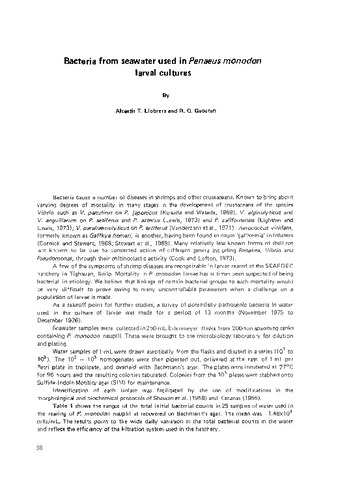Bacteria from seawater used in Penaeus monodon larval cultures
- Global styles
- MLA
- Vancouver
- Elsevier - Harvard
- APA
- Help
Share
Abstract
Bacteria in the seawater used in P. monodon hatchery operations were isolated on Bachmann's agar. The total plate counts in 25 isolations ranged from 1.0 - 5.0 x 102 to 5.1 -10.0 x 105 cells per ml. Out of 124 isolates, 98 (79 percent) were Gram-positive and 26 (21 percent) were Gram-negative. Micrococcus and Staphylococcus were dominant in the former group, while Acinetobacter, Moraxella, Flavobacterium and Alcaligenes were most numerous in the latter. Twenty-nine of the Gram-positive isolates closely resembled Peptostreptococcus, Planococcus, and Pediococcus.
Description
Extended abstract only.
Suggested Citation
Llobrera, A. T., & Gacutan, R. Q. (1977). Bacteria from seawater used in Penaeus monodon larval cultures. SEAFDEC Aquaculture Department Quarterly Research Report , 1(1), 38-40. http://hdl.handle.net/10862/2284
Type
ArticleCollections
Related items
Showing items related by title, author, creator and subject.
-
An overview of the nutrition, feed and feeding techniques of prawn penaeid/shrimps
Piedad-Pascual, Felicitas (Philippine Council for Aquatic and Marine Research and Development, 1989)This paper echoes what transpired during the first International Conference of Penaeid Prawns/Shrimps held in Iloilo City in December 4-7, 1984, particularly on the Nutrition nd Feed Development. Around 25 papers were ... -
Series: Aquaculture extension manual; No. 19
Prawn hatchery operations
Parado-Estepa, Fe D.; Quinitio, Emilia T. ; Borlongan, Emeterio L. (Aquaculture Department, Southeast Asian Fisheries Development Center, 1996-05)
The manual, an updated version of the 1984 SEAFDEC/AQD manual, presents the underlying principles and step-by-step instructions of prawn larval and post-larval rearing. The techniques described are not only applicable to ...
; Borlongan, Emeterio L. (Aquaculture Department, Southeast Asian Fisheries Development Center, 1996-05)
The manual, an updated version of the 1984 SEAFDEC/AQD manual, presents the underlying principles and step-by-step instructions of prawn larval and post-larval rearing. The techniques described are not only applicable to ... -
The lowdown on world shrimp culture - II
Yap, Wilfredo G. (INFOFISH, 2001)This paper introduces some new members of the international shrimp culture club and goes on to discuss some recent technological innovations in the industry, particularly the polyculture of tilapia (mainly Oreochromis ...







